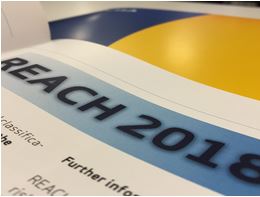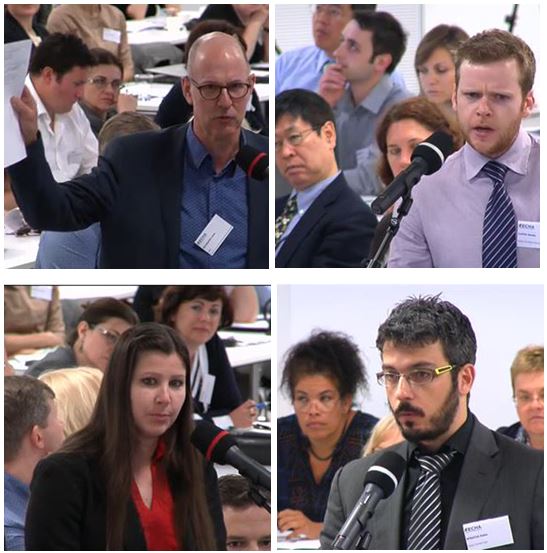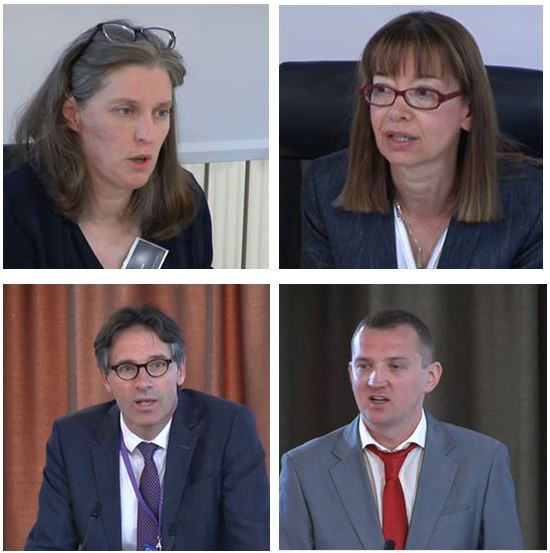The European Chemicals Agency (ECHA) held its eleventh Stakeholders’ Day at their Conference Center in Helsinki, Finland, on May 25, 2016 with over 300 participants from over 30 countries. In addition, the event was streamed online to about 450 participants.
According to the European Union’s comprehensive regulation for industrial chemicals, known as REACH, by May 31, 2018, companies manufacturing or importing chemicals in amounts of ≥ 1 t per year need to have registered their substances. So the main focus of the event was on preparing for this REACH registration deadline and on advice and best practice on how to register. Another strong focus was on small and medium sized enterprises (SMEs).
The Stakeholders’ Day included plenary talks, extended Q&A sessions, and participants had the possibility to book one-on-one sessions with ECHA’s scientific experts to discuss specific topics. Plenary talks were organized in three sessions on successful registration, ensuring dossier quality, and how the registration data is used.
During the presentations.
Road to REACH 2018 as ECHA Sees It
The Stakeholders’ Day took place 735 days before the 2018 REACH deadline. ECHA launched a REACH 2018 awareness raising video to spread the word about the deadline where all chemicals have to be registered. In their opinion, many companies are still in the “wait-and-see mode” and have not started working on their compliance, although time is getting short. Especially if contract research organizations (CROs) and/or consultants will be necessary to complete data for substances, this might further slow down the registration process.
ECHA expects to receive up to 60,000 dossiers for the 2018 deadline. This will be up to three times more than for the 2010 deadline where companies manufacturing or importing chemicals in amounts of ≥ 100 t per year needed to register their substances. The Agency also expects many more SMEs to be involved this time. So far, ECHA has received 5,700 registrations for about 3,000 substances. The top three countries are Germany (31 %), UK (14 %), and The Netherlands (9 %).
REACH 2018 awareness raising video: Register now to stay on the market.
Quality of Registration Data
Another point of concern by ECHA is the quality of the registration dossiers. REACH makes companies responsible for the safety of chemicals they place on the market. When preparing their dossiers, registrants should keep in mind that the data are a starting point for ensuring the safe use of chemicals in their company and products, and that the data will be used to do risk management within the EU. The data can be re-used for EU laws or for new legislations worldwide. Therefore, proactive investment in delivering good quality data and in updating dossiers is fundamental. Otherwise it is impossible to differentiate between substances that can be used safely and those that cannot.
Jack De Bruijn, Director of Risk Management of ECHA, said that “quality dossiers are a REACH obligation but also a fundamental to demonstrate corporate social responsibility”.
Members of the audience posing questions during the Q&A sessions.
Self Help Group of British SMEs
Many of the companies affected by the 2018 deadline are SMEs. Janet Greenwood, Secretary of the UK Chemical Regulations Self Help Group, introduced the work of her group and spoke about the main problems and possible solutions members of the group have identified. Overall, costs are the main worry of SMEs.
REACH is an unavoidable major impact on the business which will affect the growth of SMEs. Janet Greenwood gave an example of one of her members, a genuine SME. They have a turnover of £3.6m with a net profit of £110k/annually and 21 staff. They have eight substances to register, all in the 1–10 tonnage band. If they are to be the lead or the only registrant, the estimated costs are about £60k per substance. This would mean a total bill of £400k. If they would be a member registrant, assuming there would be one other registrant, their estimated costs would be £33k per substance which would still give a total of £264k. On their net profit, this is a very serious situation to be in. (see explanation of lead and member registrant)
The SME could register what they could afford. This would be two substances as lead registrant or perhaps three or four substances as member registrant. However, this would reduce their product range and would be very annoying for their customers. They could reduce staff numbers to pay for registration, but that reduces their business capability going forward. They could take out a business loan which puts extra financial risk on the business and it could end up with them going under.
Even if they register all eight substances for 2018, they also have 25 substances which are just under the 1 t/yr limit. If they want to increase sales of these, within REACH scope it would take them eight years’ profits to register them (as member registrants). Therefore, joint submission is very important.
The Self Help Group has developed an IT tool for calculating costs. The lead registrant imports the costs for each tonnage band which is then shared equally between all of the registrants in each tonnage band. The tool does that automatically. It produces reports, automatically generates the price which changes as more people join, and also gives a list of the refunds which can be added off. It allows the lead registrant to communicate easily to the respective registrants.
Other main problems identified include finding out who the lead registrant is for an existing registration, what to do when no lead registrant exists or when communication with a lead registrant is slow or non-existent, and what to do when identity and sameness tests take longer for complex substances than expected.
The Self Help Group was originally set up in 2006 to discuss how SMEs could deal with the REACH and CLP (Classification, Labeling and Packaging) regulations. The group has members from over 45 chemical companies and meets about every three months to discuss problems and to try to give answers to common problems instead of focusing on single individual cases.
Use of Registration Data
Registration is not there for itself, but the data should be accessible to ensure the safe use of chemicals. ECHA, therefore, publishes non-confidential data on its website. It can be viewed and searched free-of-charge. Currently, the data is available in three layers of complexity: the simple infocard, the more detailed brief profile, and the full source data.
The public data is also used in the QSAR toolbox for chemical property modeling and it is linked to the eChemPortal of the OECD (Organization for Economic Co-operation and Development). This is a website that enables searches of data across public regulatory databases from OECD countries.
Other Topics Discussed
Other topics addressed at the Stakeholders’ Day included how to best work with co-registrants, tools and templates for a successful information exchange on supply change, how well REACH is working, which post registration activities ECHA will take up after 2018, and what they do with the registration data. Also, many case studies were given.
Top left to bottom right: Janet Greenwook, UK Chemical Regulations Self Help Group, Christel Musset, ECHA Director of Registration, Jack De Bruijn, ECHA Director of Risk Management, Eoin Brennan, ECHA Scientific Officer of Dissemination.
The Stakeholders’ Day was followed by the Helsinki Chemicals Forum (HCF) at the Messukeskus Helsinki Expo and Convention Centre. This is an independent forum engaging international authorities, industry leaders, NGOs, academics, the media, and other interested parties in an open dialogue to discuss the future of the global chemical risk management.
- European Chemicals Agency (ECHA), Helsinki, Finland
- 11th Stakeholders’ Day: including the presentations and the webstream
- REACH 2018 website; entry point to all advice, such as practical tips, do’s and don’ts, checklists, webinars, new publications; available in 23 languages
Also of Interest
- Status of Safety of Chemicals in Europe,
ChemistryViews.org 27 May 2016.
– Status report on how the chemicals regulations REACH and CLP contribute to safer chemicals in Europe - Korea-REACH,
ChemistryViews.org 28 May 2016.
– South Korea’s solution for the control of chemicals - Get Fit for 2018 REACH Registration Deadline,
ChemistryViews.org 30 January 2015.
– ECHA has published a REACH 2018 Roadmap explaining how to register - Safe Use Of Chemicals,
Vera Koester,
ChemViews Mag. 2015.
DOI: 10.1002/chemv.201500045
The European Chemicals Agency (ECHA) held its 10th Stakeholders’ Day in Helsinki to inform about latest news and updates - REACH – An Overview,
ChemViews Magazine 2012.
DOI: 10.1002/chemv.201200029







